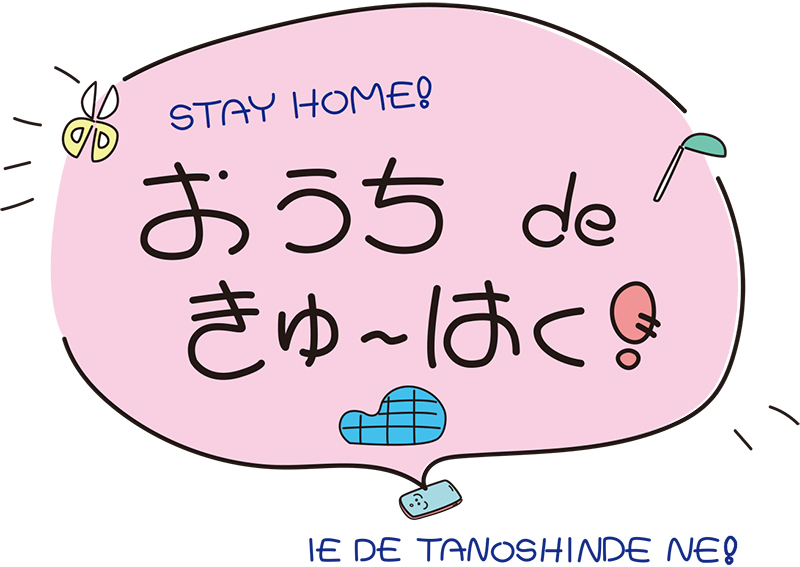
Ep. 11 Spot the Animals at Kyuhaku!
Humans have lived with animals for a long, long time. There are lots of artefacts containing animals in Kyuhaku’s collection. We might be able to find out more about the history that humans have had with animals if we take a closer look! Let’s dive into this activity, where you’ll be able to find animals of different shapes and sizes.
How to
play:
① Print out the Spot the
Animals! worksheet
② Click on the image
of the exhibits to bring
them up on a big screen
③ Zoom in on the exhibit
while using the Spot the
Animals! worksheet to find all the animals!
Spot the Animals! Part 1
Nirvana (Important Cultural Property) by Myōson
In this painting, which depicts the death of the Buddha, we can see his
followers in mourning. They
have gathered lots of flowers as offerings to him, and are accompanied
by many animals. Let’s try
finding all the different types of animals here!
Hidden
Animals:
Kirin, rhinoceros, phoenix, boar, dog, cow, frog, and more....
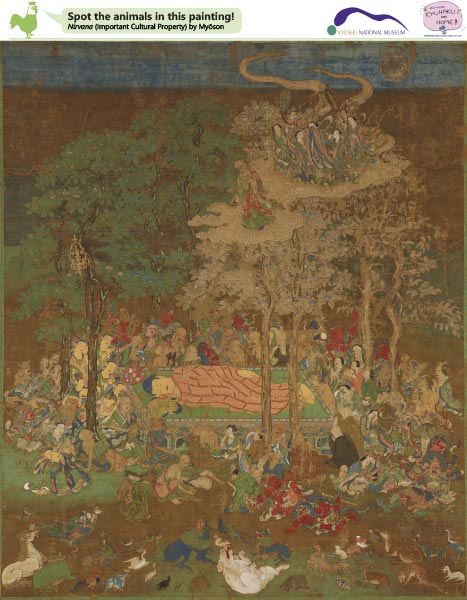
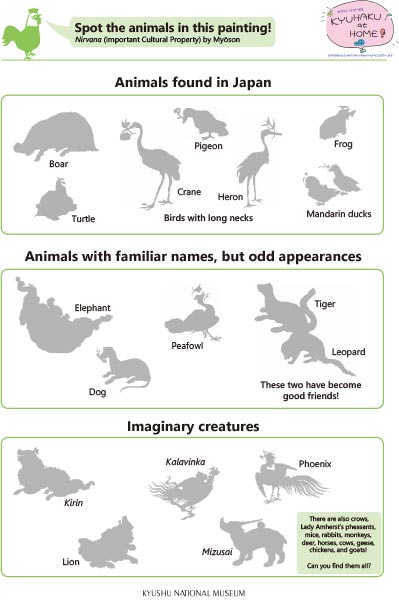
Click to download: Spot the Animals! Part 1 worksheet
The answers can be found at the bottom of this web page!
This painting depicts the Buddha, who passed away on the
fifteenth day of the second lunar
month on a moonlight night. The painting makes use of
bright colours, making it one of the
representative works from the Kamakura period. The
Buddha, who is positioned in the middle
of the work, has his head resting on his right hand. His
followers are sitting around him
holding out flowers in offering as they mourn his
passing. They are accompanied by many
different types of animals. His death bed is surrounded
by eight sal trees. The tops of
these trees extend up into the clouds, where his mother,
Queen Maya, has rushed over to see
him.
When you look over to the animals, you might find that
some of them have been painted in a
highly unrealistic way. For example, although the crows,
chickens, frogs, turtles, mandarin
ducks, and cranes are easy to recognise, animals like
the leopard, tiger, and peafowl look
quite deformed. This difference seems to have come about
due to how the latter animals are
not native to Japan, so the artist would have had to use
his imagination to portray them.
Look at the centre bottom section of the painting, which
contains a white coloured elephant
on its back, limbs facing upwards like a dog. Doesn’t it
look strange? We can tell that the
artist must have tried using existing animals in Japan
as a model for these exotic
creatures. The artist has also chosen to include several
fantastical creatures, such as the
kirin (a blue coloured lion), the
kalavinka (a bird with a long tail and a
man’s face), a phoenix, and the mizusai (a
hippo-like rhinoceros). Having such a wide
range of real and imaginary animal companions brings a
sense of liveliness to this painting.
It may be interesting to note that all the animals in
this painting are holding different
offerings to the Buddha. For example, the crane holds a
branch of a pine tree in its mouth;
the frog holds a Chinese arrowhead plant; the
mizusai offers a conch shell. They are
not
simply random choices! For example, the motif of a crane
alongside a pine tree is commonly
found in Japanese art, and is popular for its
association with longevity and good luck. The
frog and the mizusai are animals that live in or
around bodies of water, so they are
also
associated with objects relating to aquatic
environments. It is clear that the artist put in
a lot of thought into how each animal was portrayed in
this painting.
Spot the Animals! Part 2
Bed cover decorated with flower, bird, and beast motifs
This beautifully embroidered bed cover was made during the Qing
dynasty in China, and then
exported to Europe. There are lots of animals embroidered into its
design! How many of them can
you find?
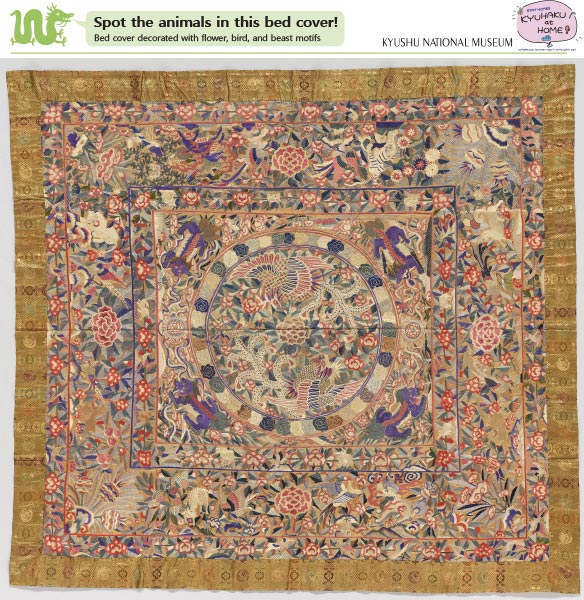
Click to download: Bed cover decorated with flower, bird, and
beast motifs
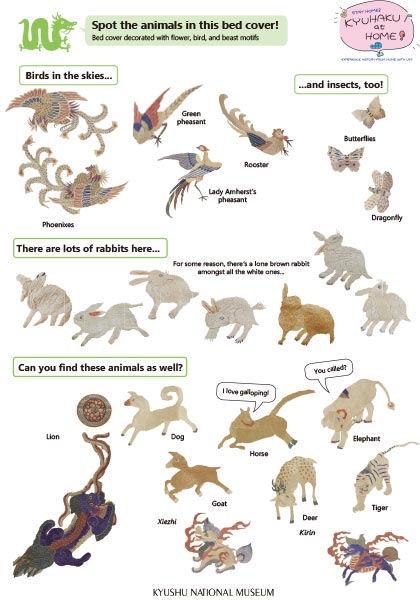
Click to download: Spot the Animals! Part 2 worksheet
The answers can be found at the bottom of this web page!
This is a bed cover that has been covered completely
with embroidery. Although there are
numerous examples of fabrics and festival floats
within Japan that are decorated with
images of the Buddha, this bed cover was originally
manufactured in China for export to
Europe. Kyushu National Museum’s collection of
Chinese objects focuses Ming dynasty
(sixteenth to seventeeth century) and Qing dynasty
(nineteenth century) objects. This bed
cover falls into the Qing dynasty portion of the
collection.
We can see that this bed cover has been divided into
sections, and embroidered richly and
extensively with patterns of flowers, birds, and
beasts. Let’s look at the playful animals
in the centre of the bed cover. A pair of phoenixes
are batting their wings around a peony
flower, which is positioned in the centre of the
design. They are framed by 4 Chinese
lions, whose foreheads contain the Chinese
character王, meaning, “king”, as they play with
temari balls attached to long, colourful
strings. On the outer border, starting
from the left and going clockwise, we can see the
following animals: the kirin
(mythical hooved animal with the body of a deer,
face of a dragon, and tail of a cow), a
tiger, a dog, a horse, the xiezhi (a mythical
goat-like creature), a deer, a goat,
and an elephant. These eight animals are kept
company by various birds, such as chickens
and Lady Amherst’s pheasants, colourful flowers,
butterflies, and dragonflies.
Pay attention to the thin area between the inner
square and the outer square – there are
nine rabbits and small birds embroidered into this
area! Interestingly enough, while most
of the rabbits are white, there is one brown rabbit
somewhere in there. I wonder why this
was the case?
As you may have noticed, these animals have fairly
deformed features and may be hard to
recognise at first. However, the feathers of the
birds, such as the chickens and
pheasants, seem to have been embroidered with
exceptional attention to detail, causing
them to seem very realistic. This points towards the
craftsman’s skill and dexterity.